France

France facts and history in brief
Coutances, was once the capital of
the Cotentin peninsula.
Coutances also have the superb
Norman Gothic cathedral,
the Cathedrale Notre Dame.

COUTANCES
from "French Cathedrals, Coutances", written by
Jocelyn Perkins, edited by The Sheldon Press.
The name of COUTANCES and much of its importance
is derived from Imperial Rome.
Originally the capital of a tribe known as
the Unelles, and called Cosedia, it fell a
victim to one of Julius
Caesar's lieutenants in 58 B.C.
Subsequently its name was changed to Constantia
in honour of the Emperor Constantius Chlorus ;
and with its castle, forum, temple, and fortifications,
to say nothing of its splendid strategic position,
it became a place of great importance.
Christianity was brought to Constantia in
the fifth century by St. Ereptiole, who became
its first Bishop, and erected a one-aisled
basilica on the site of the pagan temple,
where the Cathedral now stands.
Coutances, as it must now be called, suffered
terribly at the hands of the Scandinavians -
first the Danes, and then the Northmen.
The great promontory known as the Cotentin
was ravaged by Hasting in 837, while thirty
years later the Northmen did such terrible
damage to the city that the Bishop and his
Chapter had to fly to St. Lo, subsequently
migrating to far-distant Rouen.
Here they remained for one hundred and sixty
years, and their Cathedral city must
have been left desolate and bare.
The formation of the Duchy of Normandy, and
the adhesion of Rollon to Christianity, brought
relief to this distracted region; but not until
the time of Duke Richard the Fearless, in the
first half of the eleventh century, was any
attempt made to restore Coutances
to its original splendour.
In 1030 a capable man, Bishop Robert, put on end
to the long exile of the Bishops of Coutances at
Rouen, and with the help of Gonnor, the widow of
Duke Richard, set about the building
of a new Romanesque Cathedral.
An even more remarkable man appeared eighteen years
later, Geoffroi de Montbray, who occupied the See
of Coutances for nearly half a century.
He became one of the most trusted of all William
the Conqueror's lieutenants.
He was present at the Battle of Hastings, and a few
weeks later took part, together with Ealdred, Archbishop
of York, in the coronation of the Duke in Westminster
Abbey.
A family named Tancred, cousins of Bishop Geoffroi
lived within a short distance of Coutances.
It fell to the lot of this impecunious family of
adventurers to found dynasties, protect a Pope,
and defeat both the Holy Roman Emperor and
his comrade at Constantinople.
Devoted sons of the Church, these monarchs of the
Kingdom of the Two Sicilies were as generous
as they were courageous.
They lavished their wealth upon their episcopal
cousin at Coutances, and, thanks to this timely
aid, Geoffroi had the joy of consecrating the
nave of his Cathedral in the presence of Duke William
just ten years before the two men set forth
upon their English adventures.
Later on, Geoffroi succeeded in adding two massive
towers at the west end, which rose to
the height of nearly 100 feet.
Eastward he erected an equally striking central
tower, surmounted by a celebrated gilded cock.
When he passed away in 1093, old and well stricken
in years, he had the satisfaction of knowing that
his task was done, and that his Cathedral stood
complete in all the massive splendour
of its Romanesque architecture.
The twelfth century is a blank, so far as
Coutances Cathedral is concerned; but in 1204
when the Duchy of Normandy fell into the hands
of Philip Augustus, King of France, art generally
flourished everywhere, not least at Coutances.
At this time, another great Bishop, Hugh de
Morville, carried out an amazing
transformation of his church.
He encased the old Romanesque nave of Geoffroi
de Montbray, with new stone, completely
converting its original features.
Thus, the great church has come to bear the stamp
of the thirteenth century from end to the other.
The eleventh-century building still exists, but
if the visitor wishes to discover the original
work,he must go into the two western towers, and
enter the passages above the side aisles of the nave.
Later on in the same century appeared the choir, the
transept, and the two western spires, an immense piece
of work, which must be attributed to Jean d'Essey, who
was Bishop from 1248 to 1274.
A cloister which has now disappeared followed on
the north side of the nave, and before the end of
thirteenth century another Bishop, Robert
d'Harcourt, built walls around the Cathedral.
During the Hundred Years' War both city
and Cathedral suffered severely.
The place suffered a terrible siege, and was
just saved from falling by the timely arrival
of a French army - a fate it failed to escape
however later on after the Battle of Agincourt.
In 1364, as a result of the damage done on
this former occasion, Charles V ordered the
city to be surrounded by walls, so as to
give a greater measure of protection.
About the same time there appeared another
of the great Bishops to whom Coutances owed
so much, Sylvestre de la Cervelle, a relative
of the famous Constable, Bertrand du Guesclin.
He at once set about raising money, and during
the sixteen years of his episcopate (1370-1386)
accomplished an immense work of renovation.
The choir and apse were almost entirely rebuilt,
the easternmost chapel was added, and certain
details altered in the decoration of the nave.
Finally, the same energetic prelate constructed a
number of the nave chapels, which, with their
fascinating partition walls, form such a beautiful
feature of Coutances Cathedral.
By this time this noble church was complete.
No addition has been made to it since, nor any
essential modification, save the outrageous
destruction of the rood-screen
in the eighteenth century.
From end to end it does not, so far as its architecture
is concerned, display the very slightest trace
of either Flamboyant or Renaissance feeling.
It was however to suffer more damage.
During the Wars of Religion it was shamelessly
profaned by the Protestants, led first of all by
Gabriel de Montgomery in 1561, and
then by Colombières in 1566.
Its furniture and artistic treasures were ruthlessly
destroyed, but the actual fabric
escaped comparatively lightly.
Since the sixteenth century the history of both
city and Cathedral has been uneventful, save for
the horrors of the French Revolution, during which
time the Cathedral was used as a storehouse for grain,
a temple of Reason, and a temple of the Supreme Being.
Statues were ruthlessly smashed, and the Cathedral
was stripped of its stalls and other woodwork,
its iron grilles, and a number of
the altars in the chapels.
Later on, lead was removed from the roof
for the purpose of making ammunition.
Whatever the Protestants had spared two centuries
before was now handled mercilessly; indeed,
the Cathedral itself was only saved from ruin by
the bold and friendly intervention of M. Duchamel,
the representative of the
Government in this region.
A certain amount of drastic restoration took place
during the nineteenth century, but, apart from this,
it is clear that Coutances Cathedral has undergone
no alteration since the fourteenth century.
Coutances is not just a town of the beautiful
Cathedral and history!
Coutances is proud of its beverages
such as Calvados & Cider and the top
quality Foie-Gras produced locally.
'La Teurgoule' is another local tradition which,
if you like rice pudding,
is sure to get the taste buds going.

Hui Chin and I enjoyed Coutances and
the friendly people, especially the nice and
helpful lady at the Post Office.

You can click on these photos for an enlargement.
2005
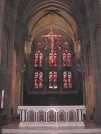 |
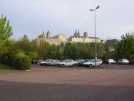 |
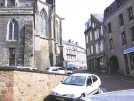 |
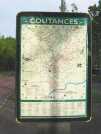 |
| Coutances |
Coutances |
Coutances |
Coutances |
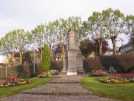 |
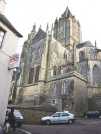 |
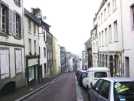 |
 |
| Coutances |
Coutances |
Coutances |
Coutances |
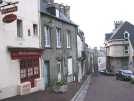 |
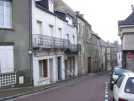 |
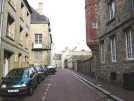 |
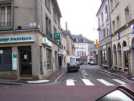 |
| Coutances |
Coutances |
Coutances |
Coutances |
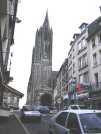 |
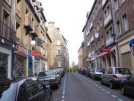 |
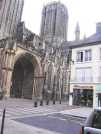 |
 |
| Coutances |
Coutances |
Coutances |
Coutances |
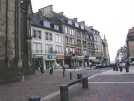 |
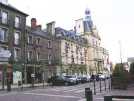 |
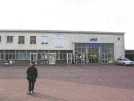 |
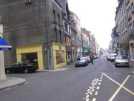 |
| Coutances |
Coutances |
Coutances |
Coutances |
 |
 |
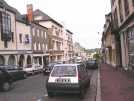 |
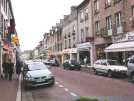 |
| Coutances |
Coutances |
Coutances |
Coutances |
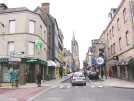 |
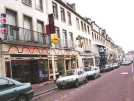 |
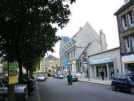 |
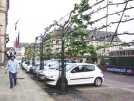 |
| Coutances |
Coutances |
Coutances |
Coutances |
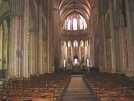 |
 |
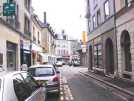 |
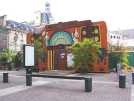 |
| Coutances |
Coutances |
Coutances |
Coutances |

Site
Index
Back to Top
Photos Index
Thanks for coming, I hope you
have enjoyed it, will recommend
it to your friends, and will come
back later to see my site developing
and expanding.
I'm trying to make my pages
enjoyable and trouble free for everyone,
please let me know of any mistakes
or trouble with links, so I can
fix any problem as soon as possible.
These pages are best viewed with monitor
resolution set at 640x480 and kept simple
on purpose so everyone can enjoy them
across all media and platforms.
Thank you.
You can e-mail me at
Webmaster

|